Papillary thyroid cancer staging: Difference between revisions
(Created page with "__NOTOC__ {{Papillary thyroid cancer}} {{CMG}}; {{AE}} {{Ammu}} ==Overview== ==Staging== ===Stage=== Based on overall cancer staging into stages I to IV, papillary thyroid...") |
m (Bot: Removing from Primary care) |
||
| (24 intermediate revisions by 2 users not shown) | |||
| Line 1: | Line 1: | ||
__NOTOC__ | __NOTOC__ | ||
{{Papillary thyroid cancer}} | {{Papillary thyroid cancer}} | ||
{{CMG}}; {{AE}} {{Ammu}} | {{CMG}}; {{AE}} {{Ammu}} {{Sahar}} | ||
==Overview== | ==Overview== | ||
According to the American Joint Committee on Cancer (AJCC) there are 4 stages of papillary thyroid cancer based on the [[clinical features]] and findings on [[imaging]]. Each stage is assigned a letter and a number that designate the [[tumor]] size, number of involved [[lymph node]] regions, and [[metastasis]]. | |||
==Staging== | ==Staging== | ||
* According to the American Joint Committee on Cancer (AJCC) there are 4 stages of papillary thyroid cancer based on the [[clinical features]] and findings on [[imaging]].<ref name="urlThyroid Cancer Treatment (Adult) (PDQ®)–Health Professional Version - National Cancer Institute">{{cite web |url=https://www.cancer.gov/types/thyroid/hp/thyroid-treatment-pdq#_441_toc |title=Thyroid Cancer Treatment (Adult) (PDQ®)–Health Professional Version - National Cancer Institute |format= |work= |accessdate=}}</ref> | |||
* Each stage is assigned a letter and a number that designate the [[tumor]] size, number of involved [[lymph node]] regions, and [[metastasis]]. | |||
{| class="wikitable" | |||
|+ | |||
! colspan="4" style="background:#4479BA; color: #FFFFFF;" align="center" + |Primary tumor | |||
|- | |||
| align="center" style="background:#f0f0f0;" |'''Tumor size''' | |||
| align="center" style="background:#f0f0f0;" |'''Sub-stage''' | |||
| align="center" style="background:#f0f0f0;" |'''Finding''' | |||
|'''Image''' | |||
|- | |||
| T0 | |||
| || | |||
* No evidence of primary [[tumor]] | |||
| | |||
|- | |||
| T1 | |||
| || | |||
* [[Tumor]] ≤2 cm in greatest dimension limited to the [[thyroid]] | |||
| | |||
|- | |||
| T1 | |||
| a|| | |||
* [[Tumor]] ≤1 cm, limited to the [[thyroid]] | |||
| [[Image:Diagram showing stage T1a thyroid cancer CRUK 250.png|200px|thumb|none]] | |||
|- | |||
| T1 | |||
| b|| | |||
* [[Tumor]] >1 cm but ≤2 cm in greatest dimension, limited to the [[thyroid]] | |||
| [[Image:Diagram showing stage T1b thyroid cancer CRUK 251.svg.png|200px|thumb|none]] | |||
|- | |||
| T2 | |||
| || | |||
* [[Tumor]] >2 cm but ≤4 cm in greatest dimension, limited to the [[thyroid]] | |||
| | |||
|- | |||
| T3 | |||
| || | |||
* [[Tumor]] >4 cm limited to the [[thyroid]], or gross extrathyroidal extension invading only strap [[muscles]] | |||
| [[Image:Diagram showing stage T3 thyroid cancer CRUK 265.png|200px|thumb|none]] | |||
|- | |||
|T3 | |||
|a | |||
| | |||
* [[Tumor]] >4 cm limited to the [[thyroid]] | |||
| | |||
|- | |||
|T3 | |||
|b | |||
| | |||
* Gross extrathyroidal extension invading only strap [[muscles]] ([[sternohyoid]], [[sternothyroid]], [[thyrohyoid]], or [[Omohyoid muscle|omohyoid muscles]]) from a [[tumor]] of any size | |||
| | |||
|- | |||
| T4 | |||
| || | |||
* [[Tumor]] includes gross extrathyroidal extension beyond the strap [[muscles]] | |||
| | |||
|- | |||
| T4 | |||
| a|| | |||
* [[Tumor]] with gross extrathyroidal extension invading subcutaneous [[Soft tissue|soft tissues]], [[larynx]], [[trachea]], [[esophagus]], or [[recurrent laryngeal nerve]] from a [[tumor]] of any size | |||
|[[Image:Diagram showing stage T4a thyroid cancer CRUK 272.png|200px|thumb|none]] | |||
|- | |||
| T4 | |||
| b|| | |||
* [[Tumor]] with gross extrathyroidal extension invading [[prevertebral fascia]] or encasing the [[carotid artery]] or [[mediastinal]] vessels from a [[tumor]] of any size. | |||
|[[Image:Diagram showing stage T4b thyroid cancer CRUK 273.png|200px|thumb|none]] | |||
|- | |||
| TX | |||
| || | |||
* Primary [[tumor]] cannot be assessed | |||
| | |||
|- | |||
|+ | |||
! colspan="4" style="background:#4479BA; color: #FFFFFF;" align="center" + |Regional lymph node involvement | |||
|- | |||
| align="center" style="background:#f0f0f0;" |'''Node involvement''' | |||
| align="center" style="background:#f0f0f0;" |'''Sub-stage''' | |||
| align="center" style="background:#f0f0f0;" |'''Finding''' | |||
|'''Image''' | |||
|- | |||
| N0 | |||
| || | |||
* No [[lymph node]] involvement | |||
| | |||
|- | |||
|N0 | |||
|a | |||
| | |||
* One or more cytologically or [[histologically]] confirmed benign [[lymph nodes]] | |||
| | |||
|- | |||
|N0 | |||
|b | |||
| | |||
* No [[Radiological|radiologic]] or clinical evidence of locoregional [[lymph node]] [[metastasis]] | |||
| | |||
|- | |||
| N1 | |||
| || | |||
* [[Metastasis]] to regional nodes | |||
| | |||
|- | |||
| N1 | |||
| a|| | |||
* [[Metastasis]] to level VI or VII ([[Pretracheal lymph nodes|pretracheal]], [[Paratracheal lymph nodes|paratracheal]], or [[Prelaryngeal lymph nodes|prelaryngeal]]/Delphian, or upper mediastinal) [[lymph nodes]]. This can be unilateral or bilateral [[disease]] | |||
|[[Image:Diagram showing stage N1a thyroid cancer CRUK 242.png|200px|thumb|none]] | |||
|- | |||
| N1 | |||
| b|| | |||
* [[Metastasis]] to unilateral, bilateral, or contralateral [[Cervical lymph nodes|cervical]] neck [[lymph nodes]] (levels I, II, III, IV, or V) or [[retropharyngeal lymph nodes]] | |||
|[[Image:Diagram showing stage N1b thyroid cancer CRUK 243.png|200px|thumb|none]] | |||
|- | |||
| NX | |||
| || | |||
* Regional [[lymph node]] cannot be assessed | |||
| | |||
|- | |||
|+ | |||
! colspan="4" style="background:#4479BA; color: #FFFFFF;" align="center" + |Distant metastasis | |||
|- | |||
| align="center" style="background:#f0f0f0;" |'''Presence of metastasis''' | |||
| align="center" style="background:#f0f0f0;" |'''Sub-stage''' | |||
| align="center" style="background:#f0f0f0;" |'''Finding''' | |||
|'''Image''' | |||
|- | |||
| M0 | |||
| || | |||
* No distant [[metastasis]] | |||
| | |||
|- | |||
| M1 | |||
| IV|| | |||
* Distant [[metastasis]] | |||
|[[Image:Stage M1 Thyroid cancer.png|200px|thumb|none]] | |||
|- | |||
|} | |||
{| style="border: 0px; font-size: 90%; margin: 3px;" align=center | |||
|+ | |||
|- | |||
|- | |||
|- | |||
|- | |||
|- | |||
|- | |||
|- | |||
|- | |||
|- | |||
|- | |||
|- | |||
|} | |||
<br /> | |||
{| style="border: 0px; font-size: 90%; margin: 3px;" align=center | |||
|+'''''Anatomic Stage/Prognostic Groups''''' | |||
! style="background: #4479BA; width: 120px;" | {{fontcolor|#FFF|Stage}} | |||
! style="background: #4479BA; width: 550px;" | {{fontcolor|#FFF|T}} | |||
! style="background: #4479BA; width: 550px;" | {{fontcolor|#FFF|N}} | |||
! style="background: #4479BA; width: 550px;" | {{fontcolor|#FFF|M}} | |||
|- | |||
| style="padding: 5px 5px; background: #DCDCDC;font-weight: bold" colspan=4 align=center| '''Papillary thyroid carcinoma''' | |||
|- | |||
| style="padding: 5px 5px; background: #DCDCDC;font-weight: bold" colspan=4 | '''Younger than 55 years''' | |||
|- | |||
! style="background: #DCDCDC;" |I | |||
! style="background: #F5F5F5;" |Any T | |||
! style="background: #F5F5F5;" |Any N | |||
! style="background: #F5F5F5;" |M0 | |||
|- | |||
! style="background: #DCDCDC;" |II | |||
! style="background: #F5F5F5;" |Any T | |||
! style="background: #F5F5F5;" |Any N | |||
! style="background: #F5F5F5;" |M1 | |||
|- | |||
| style="padding: 5px 5px; background: #DCDCDC;font-weight: bold" colspan=4 | '''55 years and older''' | |||
|- | |||
! style="background: #DCDCDC;" |I | |||
! style="background: #F5F5F5;" |T1 | |||
! style="background: #F5F5F5;" |Any N | |||
! style="background: #F5F5F5;" |M0 | |||
|- | |||
! rowspan="4" style="background: #DCDCDC;" |II | |||
! style="background: #F5F5F5;" |T1 | |||
! style="background: #F5F5F5;" |N1 | |||
! style="background: #F5F5F5;" |M0 | |||
|- | |||
! style="background: #F5F5F5;" |T2 | |||
! style="background: #F5F5F5;" |N1 | |||
! style="background: #F5F5F5;" |M0 | |||
|- | |||
! style="background: #F5F5F5;" |T3a | |||
! style="background: #F5F5F5;" |Any N | |||
! style="background: #F5F5F5;" |M0 | |||
|- | |||
! style="background: #F5F5F5;" |T3b | |||
! style="background: #F5F5F5;" |Any N | |||
! style="background: #F5F5F5;" |M0 | |||
|- | |||
! style="background: #DCDCDC;" |III | |||
! style="background: #F5F5F5;" |T4a | |||
! style="background: #F5F5F5;" |Any N | |||
! style="background: #F5F5F5;" |M0 | |||
|- | |||
! style="background: #DCDCDC;" |IVA | |||
! style="background: #F5F5F5;" |T4b | |||
! style="background: #F5F5F5;" |Any N | |||
! style="background: #F5F5F5;" |M0 | |||
|- | |||
! rowspan="6" style="background: #DCDCDC;" |IVB | |||
! style="background: #F5F5F5;" |Any T | |||
! style="background: #F5F5F5;" |Any N | |||
! style="background: #F5F5F5;" |M1 | |||
|- | |||
! style="background: #F5F5F5;" |T1 | |||
! style="background: #F5F5F5;" |N1 | |||
! style="background: #F5F5F5;" |M0 | |||
|- | |||
! style="background: #F5F5F5;" |T2 | |||
! style="background: #F5F5F5;" |N1 | |||
! style="background: #F5F5F5;" |M0 | |||
|- | |||
! style="background: #F5F5F5;" |T3a | |||
! style="background: #F5F5F5;" |N1 | |||
! style="background: #F5F5F5;" |M0 | |||
|- | |||
! style="background: #F5F5F5;" |T3b | |||
! style="background: #F5F5F5;" |Any N | |||
! style="background: #F5F5F5;" |M0 | |||
|- | |||
! style="background: #F5F5F5;" |T4 | |||
! style="background: #F5F5F5;" |Any N | |||
! style="background: #F5F5F5;" |M0 | |||
|- | |||
! style="background: #DCDCDC;" |IVC | |||
! style="background: #F5F5F5;" |Any T | |||
! style="background: #F5F5F5;" |Any N | |||
! style="background: #F5F5F5;" |M1 | |||
|} | |||
==Reference== | |||
{{Reflist|2}} | |||
[[Category:Endocrine system]] | |||
[[Category:Endocrinology]] | |||
[[Category:Otolaryngology]] | |||
[[Category:Disease]] | |||
[[Category:Genetic disorders]] | |||
[[Category:Types of cancer]] | |||
[[Category:Hereditary cancers]] | |||
[[Category:Thyroid disease]] | |||
Latest revision as of 23:34, 29 July 2020
|
Papillary thyroid cancer Microchapters |
|
Differentiating Papillary thyroid cancer from other Diseases |
|---|
|
Diagnosis |
|
Treatment |
|
Case Studies |
|
Papillary thyroid cancer staging On the Web |
|
American Roentgen Ray Society Images of Papillary thyroid cancer staging |
|
Risk calculators and risk factors for Papillary thyroid cancer staging |
Editor-In-Chief: C. Michael Gibson, M.S., M.D. [1]; Associate Editor(s)-in-Chief: Ammu Susheela, M.D. [2] Sahar Memar Montazerin, M.D.[3]
Overview
According to the American Joint Committee on Cancer (AJCC) there are 4 stages of papillary thyroid cancer based on the clinical features and findings on imaging. Each stage is assigned a letter and a number that designate the tumor size, number of involved lymph node regions, and metastasis.
Staging
- According to the American Joint Committee on Cancer (AJCC) there are 4 stages of papillary thyroid cancer based on the clinical features and findings on imaging.[1]
- Each stage is assigned a letter and a number that designate the tumor size, number of involved lymph node regions, and metastasis.
| Primary tumor | |||
|---|---|---|---|
| Tumor size | Sub-stage | Finding | Image |
| T0 |
|
||
| T1 | |||
| T1 | a | 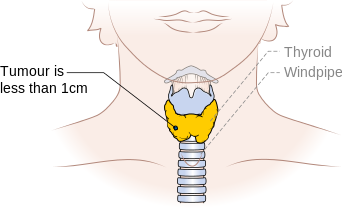 | |
| T1 | b | 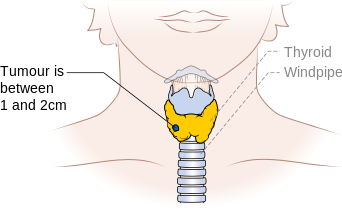 | |
| T2 | |||
| T3 | 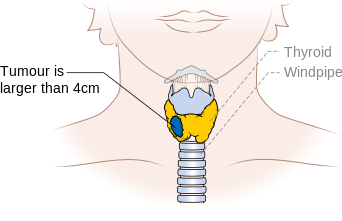 | ||
| T3 | a | ||
| T3 | b |
|
|
| T4 | |||
| T4 | a |
|
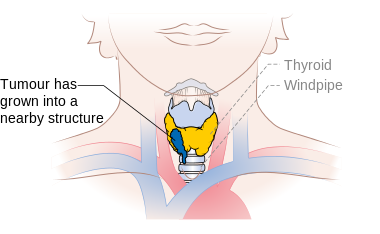 |
| T4 | b |
|
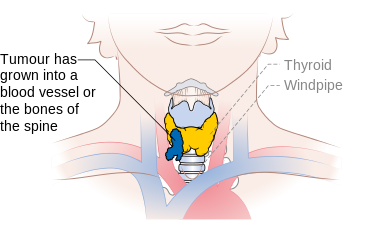 |
| TX |
|
||
| Regional lymph node involvement | |||
| Node involvement | Sub-stage | Finding | Image |
| N0 |
|
||
| N0 | a |
|
|
| N0 | b |
|
|
| N1 |
|
||
| N1 | a |
|
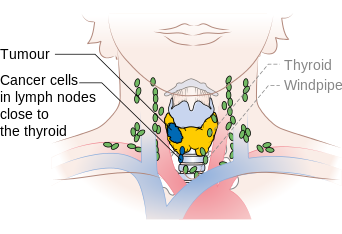 |
| N1 | b |
|
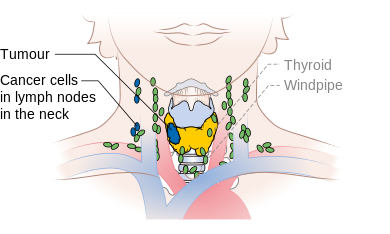 |
| NX |
|
||
| Distant metastasis | |||
| Presence of metastasis | Sub-stage | Finding | Image |
| M0 |
|
||
| M1 | IV |
|
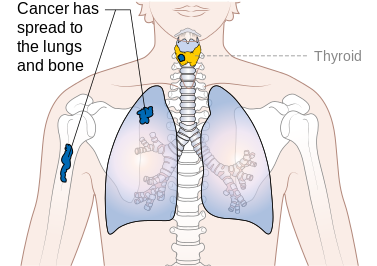 |
| Stage | T | N | M |
|---|---|---|---|
| Papillary thyroid carcinoma | |||
| Younger than 55 years | |||
| I | Any T | Any N | M0 |
| II | Any T | Any N | M1 |
| 55 years and older | |||
| I | T1 | Any N | M0 |
| II | T1 | N1 | M0 |
| T2 | N1 | M0 | |
| T3a | Any N | M0 | |
| T3b | Any N | M0 | |
| III | T4a | Any N | M0 |
| IVA | T4b | Any N | M0 |
| IVB | Any T | Any N | M1 |
| T1 | N1 | M0 | |
| T2 | N1 | M0 | |
| T3a | N1 | M0 | |
| T3b | Any N | M0 | |
| T4 | Any N | M0 | |
| IVC | Any T | Any N | M1 |